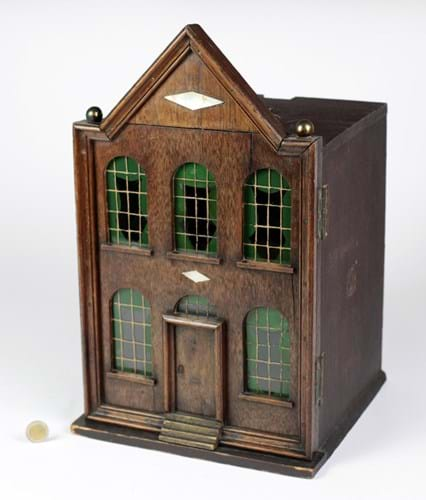With 22% buyer’s premium plus VAT added on, a UK private collector bidding by telephone paid close to €60,000 (£53,500) for the two-bedroomed miniature house that carried an estimate of €3000-4000.
The Irish Times noted that, even by the standards of the inflated Irish property market, the hammer price achieved by Fonsie Mealy for the doll's house was "exceptionally high”.
Vivien Greene collection provenance
A key attraction of this English doll’s house, made to entertain children on travels in late Georgian times, was its provenance to writer Vivien Greene (1904-2003), regarded as one of the world’s leading authorities on doll’s houses. She was married to novelist Graham Greene.
Made of mahogany, at 17.3in (44cm) high and 10.2in (26cm) wide, the house is of a type mentioned in Irish writer Jonathan Swift's 1726 classic satire, Guilliver's Travels.
Final bidding came down to two competitors on the telephone, with the hammer price taking seasoned auctioneer Fonsie Mealy by surprise. “We knew there was good interest beforehand, with the number of people registering for phone and internet bids,” Mealy told ATG.
“Some years ago we did get €26,000 for a doll’s house from Lissadell [County Sligo, home of prominent Anglo-Irish family the Gore-Booths] but I didn’t think this one would go so high, as it’s only 18 inches tall and has just two rooms. I thought it might make €20,000.
“It was a huge surprise that it reached €48,000, but there were other surprises in the sale too,” he said.
One of those surprises was the sale of an Irish Shillelagh stick, estimated at €300-400, with an engraved plaque claiming its use in a notorious faction fight in Cork in 1845 during which 10 people died, that made €4500.
Proceeds to charity
The doll’s house was consigned by the Tara’s Palace Trust charity, having acquired it at a UK auction back in 1998 for €7000. Proceeds from this week’s sale will go to Irish children’s charities.
The travelling doll’s house had been displayed at the trust’s Museum of Childhood. Another miniature house from the Vivien Greene collection owned by the trust, with four fully-furnished rooms and dating from 1700-1710, sold in the same sale for a top-estimate €12,000.
Mealy’s summer sale on July 23, held at the auctioneer’s Chatsworth Street, Castlecomer saleroom, had a total hammer of €420,000, with 85% of items sold.
A doll’s house with a mission
The back story to Tara’s Palace Trust, according to its website, is an intriguing one involving another doll’s house and a group of intrepid Irish antiques dealers.
In 1978, a doll’s house made in Ireland in the early 1900s called Titania’s Palace, was put up for auction at Christie’s in London. Ron McDonnell, a renowned Irish antiques dealer and expert in 18th century Irish furniture, led an Irish delegation determined to buy the palace back for Ireland.
However at the auction, they were trumped by the Lego corporation, which paid £135,000 to take Titania’s Palace to Legoland in Denmark, where it is a major tourist attraction.
To compensate for this loss, McDonnell and his colleagues commissioned Irish craftsmen to build a new, 22-room miniature building called Tara’s Palace, to a design based on great Irish houses, featuring antique furniture and items made by Napoleonic prisoners of war. It was made on a 1:12 scale, just like Titania’s Palace.
Individuals and companies sponsored rooms in the tiny new palace, with artists and craftspeople donating miniature furniture and artworks. On display in Dublin, it raises money for children’s charities, like its predecessor.
On the deaths of Ron McDonnell and his widow, Doreen, in the early 1990s, the Tara Palace Trust was born.






